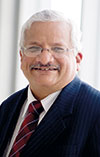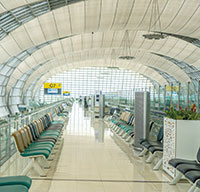

For over half a century now, Checkpoint Charlie has captured our imagination as the ultimate border crossing. Shrouded in the mysteries of cold war espionage stories, when the Berlin wall finally came down, it had 14 checkpoints that went by the names of the neighbourhoods they were located in. But earlier, they simply bore signage in the aviator alphabet – Alpha, Bravo, Charlie … and of this somehow this makeshift name of the Friedrichstrasse crossing persisted, and even after being reduced to a mere tourist attraction, it remains a poignant reminder of one of the sad aspects of nation-state politics – that of dividing people from people.

At the beginning of the twenty-first century, this drama has shifted to the airport, and thus, if you deal in security policy, strategy or technology, it becomes a microcosm to be examined in great detail. No doubt, 9/11 or rather its immediate aftermath, has been the single most important reason for this focus.
However, the definitive ideas around it came together, with more clarity than anywhere else perhaps, in the book titled Politics at the Airport, edited by Mark B. Salter. Published in 2008, it is a slim volume, with just eight papers by different authors and comes in at under two hundred pages. Professor Salter teaches political science at the University of Ottawa. Not surprisingly, the most influential bodies that govern air travel are headquartered at nearby Montreal – the International Civil Aviation Organisation (ICAO), Inter-national Air Travel Association (IATA) and the Airports Council International (ACI).
Much has happened since its publication, but the principles of border crossing and security, essentially remain the same.
A human mixing pot
Not only in scale, but also in opportunity of great architecture and commerce for example, the airport is a true twenty-first century icon. But alongside are the vulnerabilities of post-cold-war politics and terrorism. In a world that fluctuates between borderless globalisation and claustrophobic xenophobia, the airport has to be many things for its different users, all at the same time.
It brings together at a single location both, the ideas and the reality of security, territory and population. It also brings together a complex web of local, national and international laws, as well as surveillance for conflicting reasons – on behalf of companies, governments and individuals. It connects many social spheres and has to provide incarceration amidst an illusion of infinite freedom. As political scientists state, thus the airport is both – the definition of an immense problem as well as a statement of its grand solution.
Who and what are you
By the end of this decade, seven billion people are expected to pass through airports travelling nationally and internationally, consisting of about half a billion passport holders. There is already the pressure for the élite to be treated with queue-less instant service. Archaic instruments such as visas cause additional bottlenecks on an already overstretched service infrastructure.
Many of the sixty-five million internationally displaced persons also arrive at international airports, some of them seeking asylum and in the most complex legal situations, in conditions of statelessness. There are women and children requiring immediate humanitarian attention.
Amidst all this, are individuals attempting to travel on one of the over 60 million stolen or lost travel documents, individuals suspected of commercial crime, smuggling and drugs, and those with a criminal background and intent. Finally, there are the dreaded terrorists, detecting and stopping whom could prevent untold loss and tragedy. These could arrive disguised across the entire spectrum – from the élite to the asylum seeker. There is no way to tell what persona they will don next.

The freedom of restriction
Apart from ICAO, IATA and the ACI a number of other regional and national bodies formulate guiding principles for all this. In the US, it is the Federal Aviation Administration (FAA), the Transportation Security Administration (TSA) as well as the Department of Homeland Security (DHS).
Involving almost the entire community of nations, the governance environment is a combination of international treaties, national laws, local by-laws as well as management practices. The ICAO itself goes back to the Chicago Convention of 1944 (ratified in 1947) as well as its various annexures and amendments.
In a broad sense, airports have the objective to maximise national security. However, prevalent business models also require them to maximise commerce. This leads to the complex layouts and the alternating of wide-open spaces with narrow passages and barriers. Overall, it has been a question of optimising space, speed and security.
For the security aspect, initially it was considered a question of minimising the time to process. Today, the focus is on the outcome. Also in recent years, there has been a need to re-evaluate the security objective function itself, because the dependence of returns on investment in this field is difficult to quantify.
In general, security is said to depend on ID documents, identification and detection devices, CCTV and data such as no-fly lists. Viewed individually, each have well-understood shortcomings, however together, do provide a system that seems to hold. Added to this in recent years have been strategies of risk management, more comprehensive post-event assessment, and somewhat controversially, using databases as an instrument of selection, separation and exclusion.
In principle, these violate privacy and personal data protection laws. However, many agencies espouse temporary profiles bringing together data for the eyes of experts, while maintaining the essential separation in the machine form, as a bare minimum, looking at today’s threats.
Ideally, passports serve well for external movement. However, the use of ID cards for internal movement opens up many issues of acceptability, standards and authentication. Similarly, despite constant advancements, both in the technology and practice, biometrics as valves that control global flows of humanity, could be restricted only to international border crossing.
Imponderables invariably turn up, such as what happens to your data across borders. For example, the moment it reaches the United States, is it subject to the USA-PATRIOT Act? Few of us remember that this ten-letter abbreviation stands for: Uniting and Strengthening America by Providing Appropriate Tools Required to Intercept and Obstruct Terrorism, as signed by President George W. Bush on October 26, 2001. This has subsequently been extended and amended in 2011 and 2015 under the Obama administration, and is now known, quite ironically, as the Freedom Act.
A Difference Machine
For the airport then, the notion put forward underlying its laws, regulations, procedures and technologies, is to facilitate global mobility and at the same time, if required, fortress countries and continents. Smart borders has been a euphemism for the increasing use of biometrics (face and fingerprints mainly) in this context.
Peter Adey is one of the contributors in Mark Salter’s book and his paper – Mobilities and Modulations: The Airport as a Difference Machine – is a powerful one and immediately caught the imagination, not only of those wanting to tame the unwieldy airport beast, but also of businesses looking to maximise profits within. In sociological terms, he described this continuous and unending process of segregation being based on securitising identity and identification, with political asylum at one end to credit card theft at the other. At an airport, this synchronises well with the twin ideas of maximising security and commerce. In addition, both have established paradigms of profiling, though with different objectives. However, the underlying commonality of securitised identity provides a significant intersection.
Already, the mobile phone and the use of biometrics to authenticate payments provides even greater common ground, between the authority of one and the power of the other, in its capacity to organise the identification of individuals. Newer ID schemes have already breached the conventional distinction between the government and the commercial, domestic and international and the inside and the outside.
However, experts reckon that despite techniques being available, they have not been put together in the most effective way – for the identification, classification and managing of individuals and groups sorted by a level of dangerousness, so to say.
Behaviour and identity observation
Three specific areas have immediate potential. Biographic search is one of them that helps investigators look beyond singular physical identification characteristics. The biometric silos also need to be turned upside down and provided with connecting passageways. Thus names, locations, faces and other specifics can be looked at more holistically and intuitively like a human mind does.
Lastly, there is the hypothesis that identity itself is not the final frontier of security. It is the knowing that there is intent. One of the important ways that an airport functions are segregating the streams among the frequent-flying ‘kinetic élite’ (as termed by Rem Koolhaas), the more general classes, the refugees and vagabond immigrants (some needing deportation) and finally those that need a closer look for security reasons. It is not only being able to foil their passage at arrival or departure, but also keep the airport itself out of reach from being a target.
Thus there is the current debate between behaviour-based and identity-based techniques. Objections abound, and these too need to be addressed, especially those in the realm of privacy, protection, due process, discrimination, international law and conventions.
Already businesses, airlines and governments are imposing visible and invisible levies that support all means of security at the airport. With the annual traffic projected to touch seven billion passengers via thirty-five million flights in one hundred and ninety-one countries, the nine thousand odd airports where they originate and land, assume more importance than ever before.
Not one of them is known as Checkpoint Delta, but I thought to use the name to remind us of what changes and what remains the same.

© Technews Publishing (Pty) Ltd. | All Rights Reserved.